
 |
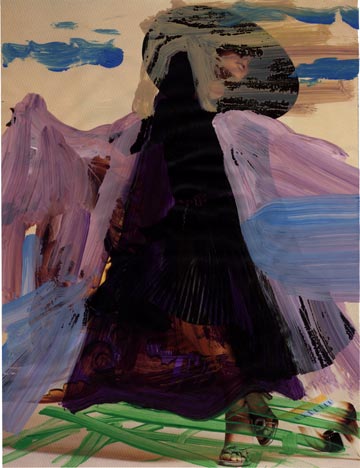
If Sisyphus detached from expectations, it'd all be in a day's work.
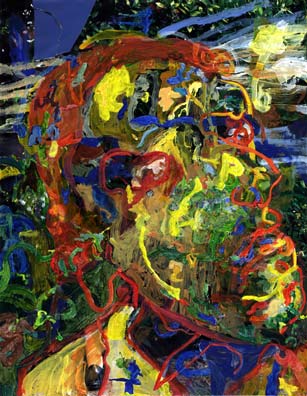
The mysterious collaborator who completes paintings while I’m not looking has struck again. I’d estimate the inscrutable hands-off master has been laboring for nearly two years to bring this painting to resolution.
When I embarked on the painting that would become Returning Wounded, I did so with no life experience of painting in the manner of a Northern European Renaissance master. I had no idea how or if I could do it. I figured though - if I never quit, I’ll never fail.
The common painting aphorism goes “paint what you see,” which - if it delivers the exclamation: “I didn’t see that coming” - seems to me like a good enough directive.
It turns out that my salvation, in this instance, would reside in technology - but not its application - just an observation: Click the magnifying glass icon from the photoshop tool bar and even the highest resolution image is revealed as consisting of discrete colors in prescribed areas - pixels in a grid. While painting, I often reoriented myself with this assuring reminder.
When complexity (or history) threaten to overwhelm, there can be utility in viewing painting reductively and simply putting the right color in the right place. That the protracted experience of clicking a mouse and staring at a computer monitor should facilitate old master painting techniques was one outcome I didn’t see coming.
While working on this canvas, my painting rhythm yielded a long walk home during hours when “The City That Never Sleeps” is at its most drowsy and my stride rode the wake of sanitation crews.
Freshly installed white plastic bags would be prepared, up and down each avenue, cinched atop the garbage baskets. Howling winds through the urban canyons occasionally treated me to hilarious inversions of these bags - setting them waving wildly above their rims, effectively reversing the order of interior versus exterior. I’d wonder just what am I looking at?
After months inside the process of creating Returning Wounded, my position has inverted to its dispassionate exterior. With the weathered directive “paint what you see” arriving at its corollary: “see what you paint,” now you and I meet in league, as viewers.
Details:
Process Video
 |
 |
 |
 |
 |
 |
 |
 |
 |
 |
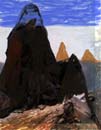 |
 |
 |
 |
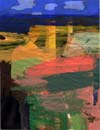 |
 |
 |
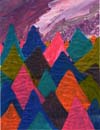 |
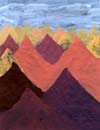 |
 |
 |
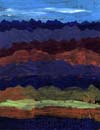 |
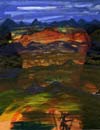 |
 |
 |
 |
 |
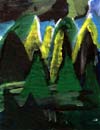 |
 |
 |
 |
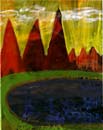 |
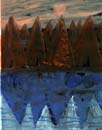 |
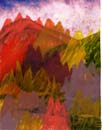 |
 |
This post struck upon a universal aspect of process in the life of every artist. It reveals the development of a thing painters, dancers, writers, photographers, all come to recognize - or have pointed out to them by others - as the artist’s “vocabulary.”
The ambition is to stretch it, inhabit it, move beyond it, eradicate it and start again. In the life of any great - Dylan, De Kooning, Streep, Barysnikov, Joyce - you see it embraced and cast off over and over.
This process, however, is hardly the sole province of acknowledged greats. It’s abundantly evident in the refinement and practice of eponymous yet anonymous local graffiti writers, worldwide.
When mountains began to rise from the horizon of my drawings a while back - lining the tops of compositions, forming eyelids and eyebrows - I delighted in having entered uncharted territory.
The iconic aspect of this particular new vocabulary struck a deep chord.
Freed from reliance on any roadmap, I set myself the charge of attaining an image and a way of working that might enable me to experience a landscape I could imagine walking into.
Several latenights into the trek, the works mounting on the wall suddenly looked like tags - shorthand symbols unlocking imagination and evoking a universal adventure through one-off expression.
These peaks seemed to rise beyond caricature in the same way great tags snake through graphic and font, infusing both with art and dusting culture across urban grit.
Among other things, a writer tags a wall or train to record his or her presence in the world and that particular corner of it. With these “Mountain Tags” I realized I was doing something similar but with a twist: recording my presence in or experience of a landscape of my imagining. Both modes of expression recognize valuing a disciplined refinement of one’s vocabulary and the humanizing worth of including that process in the public square.
So this post reveals an evolution of new vocabulary designed to read as a sign, a signifier, a refined, Romantic tag: “Mountain.”
The above images are an unedited sequence of this endeavor to date. The 32nd attempt - which I published previously as “premise en scène” - was the initial mountain painting that in some ineffable way satisfied my desire. But that’s just me, you, of course, are free to determine your own peak experience.

Behold the beauty in the eye of the beholder in this inspired art pilgrim's video.
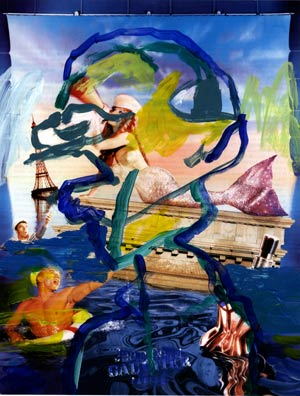
The political and military figures adorning London’s Trafalgar square are currently joined by a sculpture of another sort. Marc Quinn’s “Alison Lapper Pregnant” is the Fourth Plinth project’s newest commission.
Alison Lapper, an artist herself, was born severely physically disabled. Sculptor Quinn has this to say about her image commingling with the others on the square:
“In the past, heroes such as Nelson conquered the outside world. Now it seems to me they conquer their own circumstances and the prejudices of others, and I believe that Alison's portrait will symbolize this.”
Quinn, Lapper and the Fourth Plinth Commissioning Group have staged an all-out Beauty Conquest - expanding the realm of what constitutes a recognizably beautiful being.
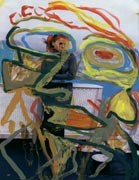 |
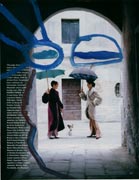 |
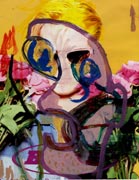 |
The golf club is analogous to the paint brush. Despite an afternoon’s circuitous trek through compelling pastoral vistas punctuated by dramatic physical exertion, it doesn’t take long to realize that, fundamentally, golf is a mental discipline. Last week, for the first time, I tried my hand at a round of golf and, in this one regard, the terrain was familiar.
For years, Chuck Close has used golf as a metaphor to offer entrance into his particular painting process. In searching the web, I found a fascinating and extensive 1987 interview with the artist wherein he explains:
Golf is kind of interesting. It's a stupid sport, but I like it because it's the only sport that I can think of in which you move from general to specific. When you're standing at the tee, you often can't even see the green or the hole where you're going to ultimately end up. So the first stroke is just out there somewhere, and the second stroke attempts to correct and refine the direction. On a par four course, by the third stroke, you should be on the green. You're now getting very close to what you want, and then you hopefully can putt out on the fourth stroke. Now you're someplace very specific --this very small circle. I like the idea of having a certain number of steps to take to move from general to specific, and I like the idea of building a painting rather than painting it. So I conceived of each one of the squares in the original oil paintings as a kind of par four course. But just to make things more interesting, I would tee off in the opposite direction.
•••
(Y)ou always have the possibility of coming in a stroke early with a birdie. Clearly, I'm not going to stop until it's right. I'll put on as many strokes as necessary, just as in playing golf you've got to keep making strokes until you find the green. So, you could get a bogey or a double bogey or you can have the aesthetic equivalent of being mired down in the sand trap, where you keep making stroke after stroke after stroke and not getting anywhere.
With the three new paintings posted above, I was definitely going for the green, aiming to bring the works to resolution in an economical, direct manner. As to whether they hit the mark or warrant the charity of a mulligan, I’ll let you be the official scorer.
In the end, for my maiden round of golf, I shot a 56 over nine holes. Gotta work on my putting.
 |
 |
 |
 |
 |
 |
 |
 |
 |
 |
 |
 |
 |
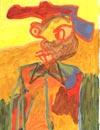 |
 |
 |
 |
 |
 |
 |
Today’s post is an inclusive offering of “latenight paintings.” This is an adaptive painting habit which has arisen recently. The end of each day has become the time for a few quick minutes of wild liberty.
During the daylight hours, it’s been all business: working the current oil painting, honing essays, connecting with Thank You Project and TINSQUO inquiries, laying the groundwork for longterm pieces, seeing notable NYC shows and simply remembering to eat. Spontaneously, just before bed, I started doing quick acrylic paintings a few weeks back.
The day’s close is now a free, inviolable space of acceptance where the inner-censor is escorted out the door. I’ve noticed that when one area of my painting practice attains a high level of resolve, a counterbalance often develops in response that yields fresh abandon and lively painting.
You might recognize two earlier posts, “alive_again_naturally” and “seeing_reticulated_canopy,” as part of this incipient series. I’ve included them, here, in the chronological sequence that's unfurled this month.
Opening up similar avenues of liberation is the way my painting practice is revitalized time and again. So, this humble series may represent the most crucial of my works. Here also, over time, a deep structure starts to evolve that - in the life of any painter - is noteworthy for its willingness to court failure.
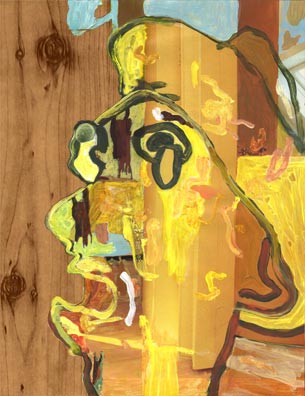
Key to the title's puzzle.
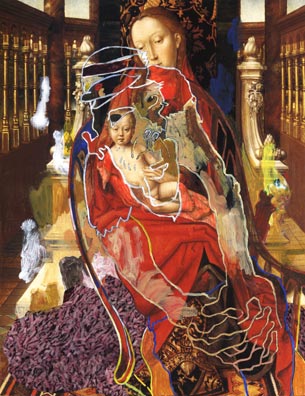
The original "Enthroned Madonna" (1490) by Hans Memling resides in Das Suermondt-Ludwig Museum, Aachen. The version I've painted upon is a page from a fashion magazine that, absent my intervention, was headed to the landfill.
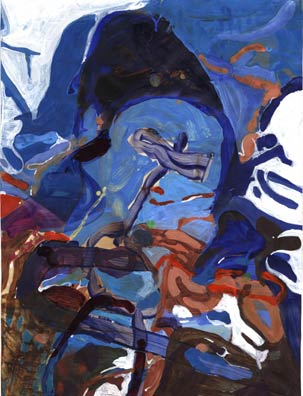
"gently_jib"
Two stories from today's New York Times hint at the possibility that someday the distinction between art and science will prove as capricious and past-tense as the Ingres/Delacroix line-versus-color battle or the Modernist abstraction-versus-realism debate:
Physicists discover/conjure/perceive new elements:
(F)or roughly half a century, nuclear scientists have been searching for an elusive "island of stability," somewhere among the superheavies, in which long-lived elements with new chemical properties might exist. Dr. Loveland said that the new results indicated that scientists might be closing in on that island."We're sort of in the shoals of the island of stability," said Dr. Kenton J. Moody, a Livermore nuclear physicist who was one of the experimenters in the work.
"It's an amazing effect," he added. "We're really just chipping away at the edges of it."
-snip-
"This is a working piece of art," Dr. Patin said. "We're not done yet. Nothing's been finished. What it could really mean down the road, nobody can tell. And that's the part that's exciting to me."
In a periodic table of another sort, artist Vincent Desiderio, with exhaustive thoroughness and care, paints the elements of six centuries of Western art. The Times' article contains the following contemplation-worthy notion:
Of all the illustrations, (Desiderio) found (the) Picasso portrait, "Leaning Woman" (1939), the most difficult image to reproduce because "Picasso's marks are so aggressively counter-intuitive."
Scientist/Artist...how anything ever got bifurcated in the first place is what I find counter-intuitive.
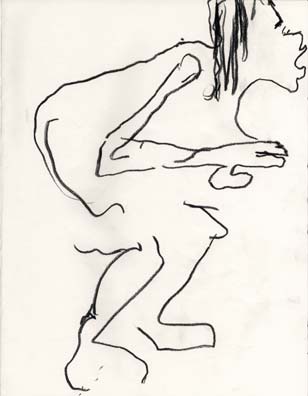
Yoga has lately proven to be a boon to the drawing. Even as a novice (its been about a year now), I've already found that the discipline dislodges the mind from the exclusive province of the head. This provides an opportunity, when drawing a figure, to move attention into the area of the body being drawn. The result is the difference between depicting the appearence of a body versus drawing that body from the experiential inside out.